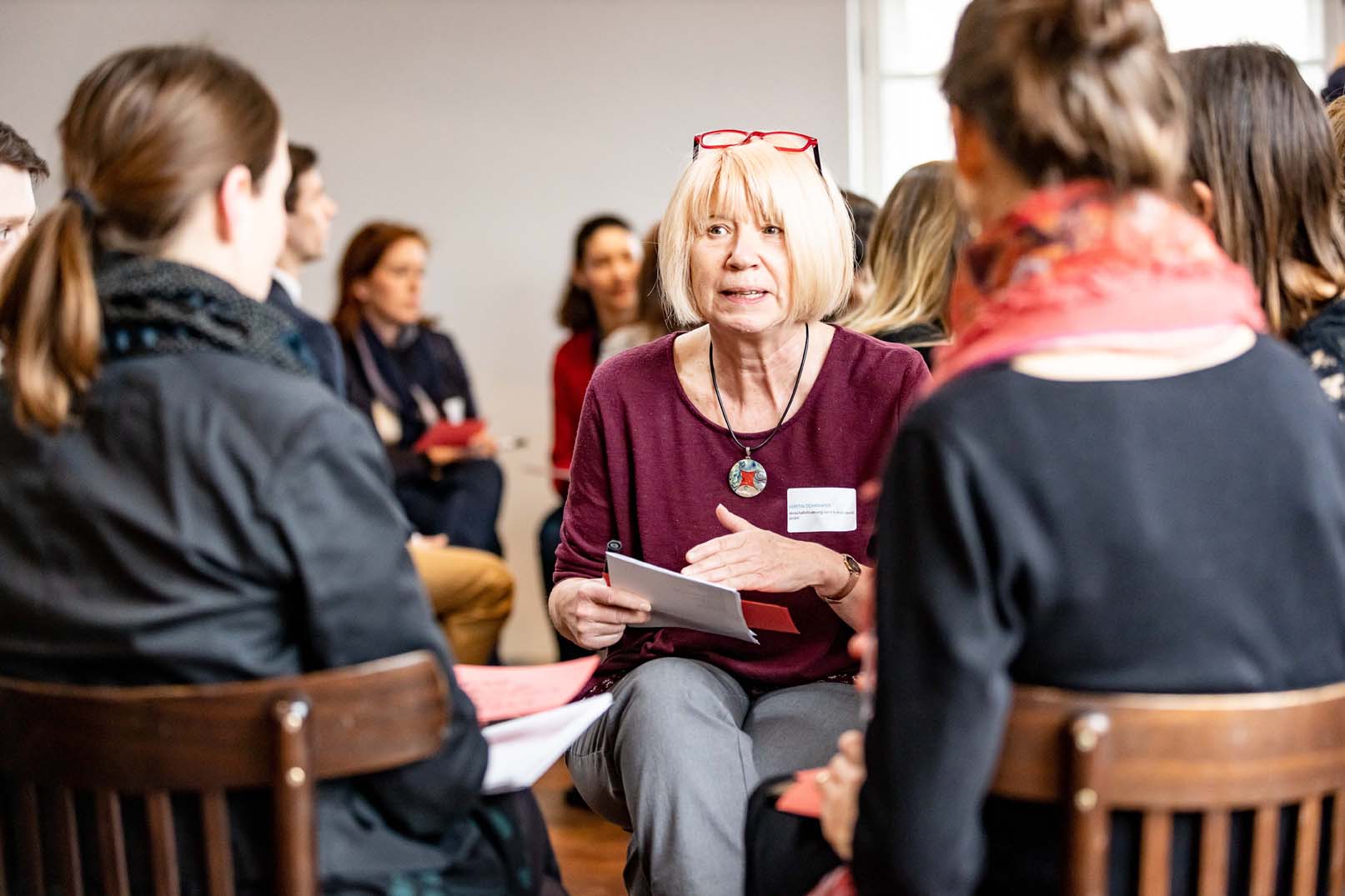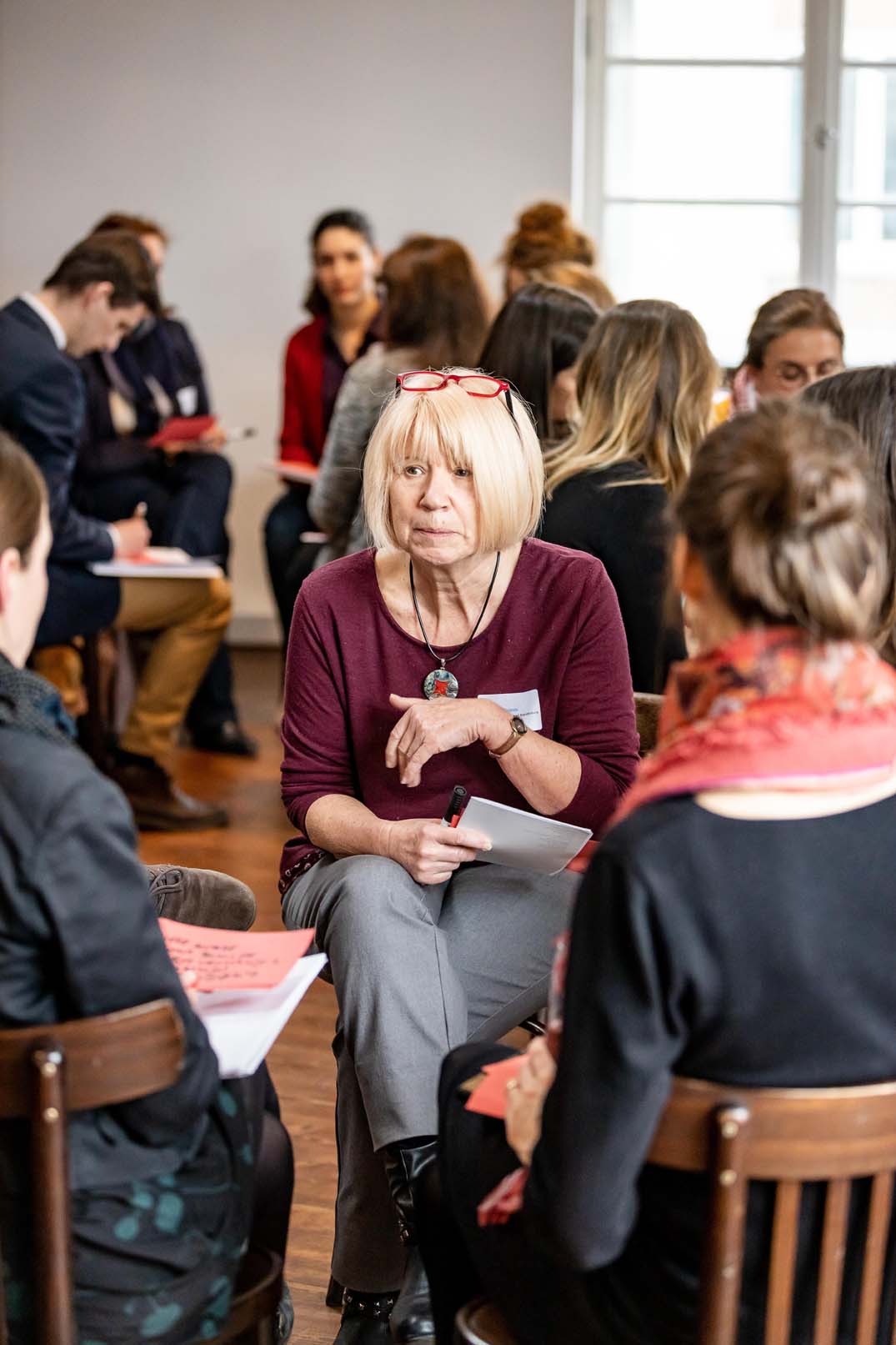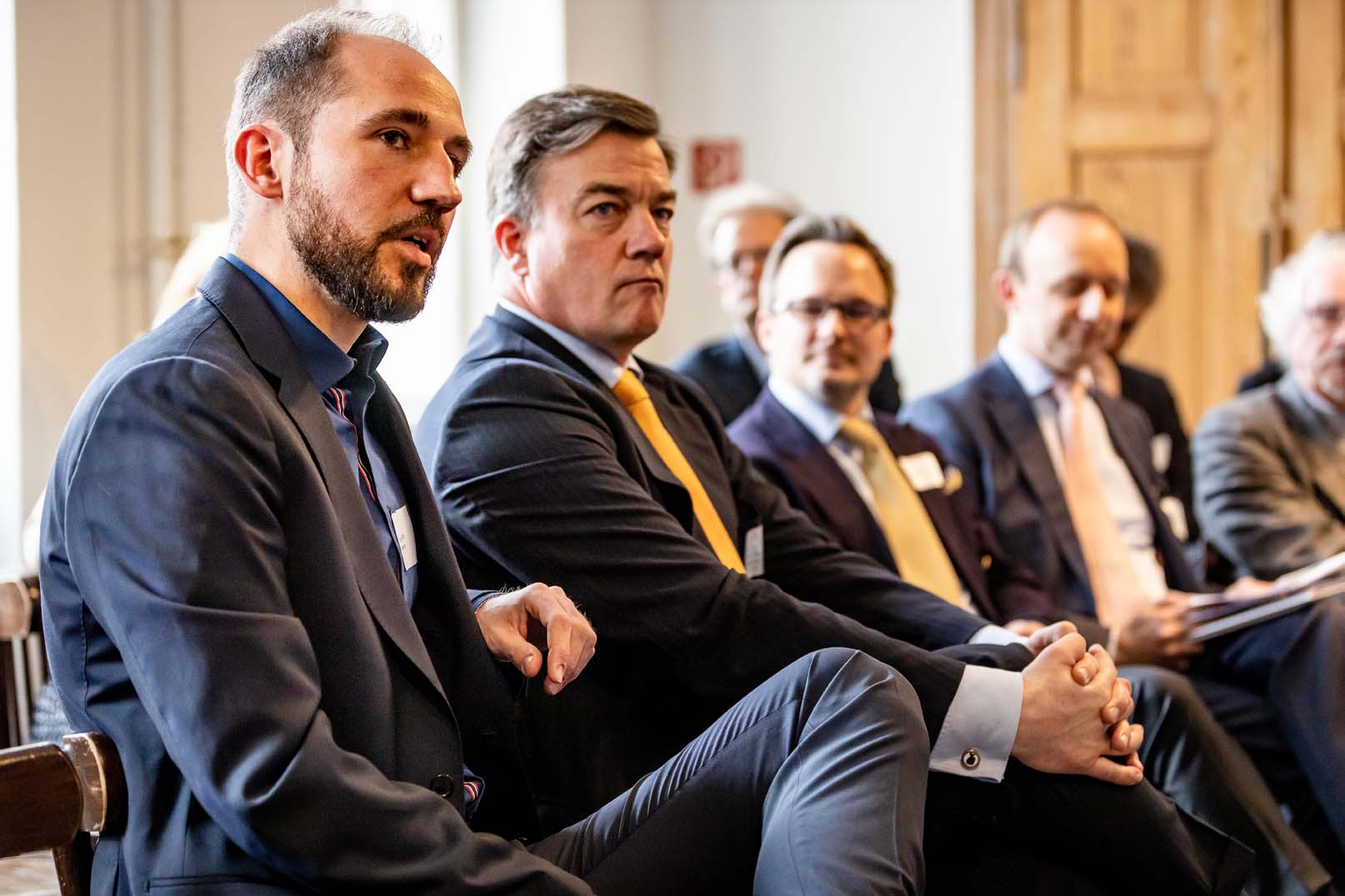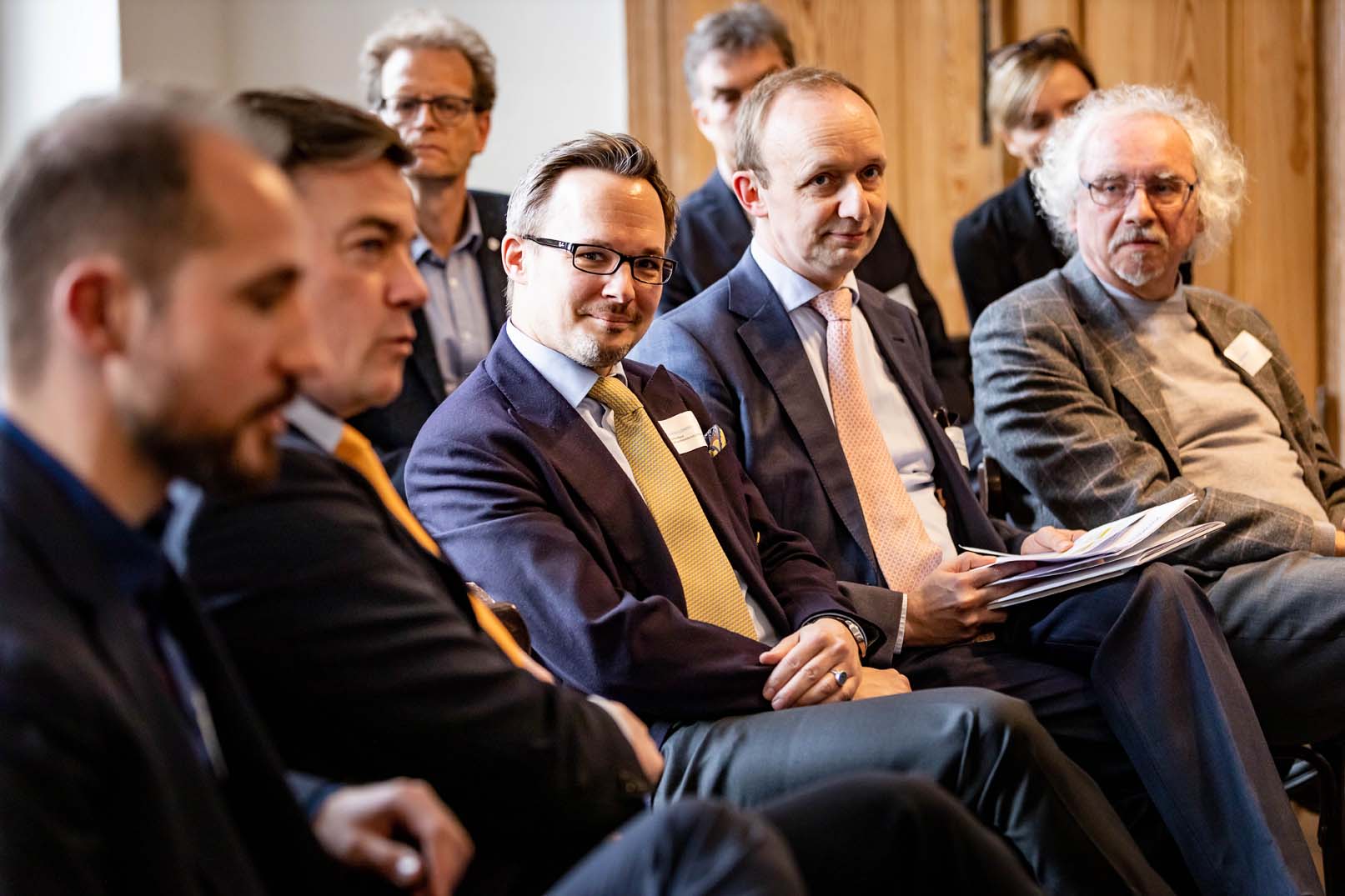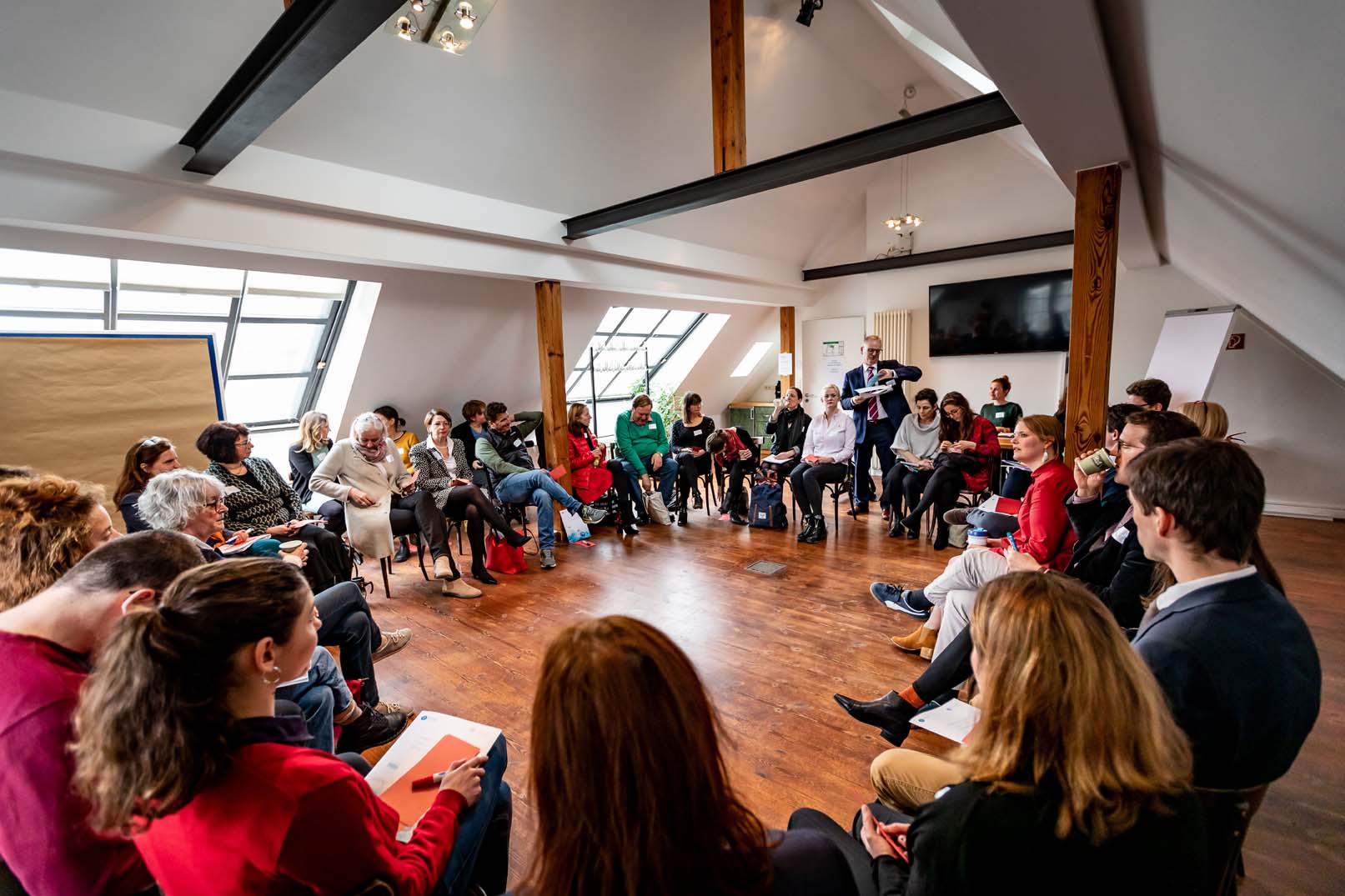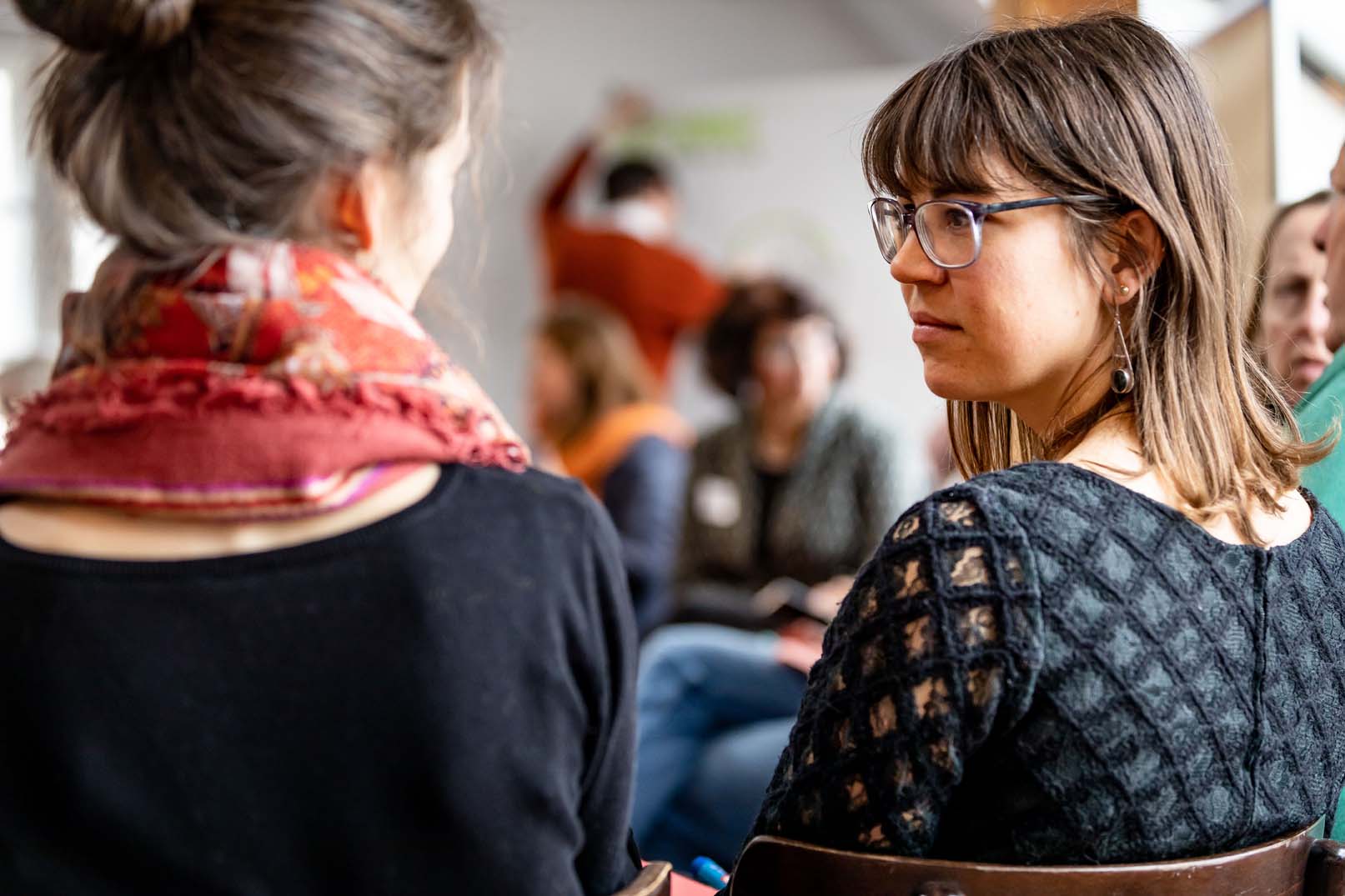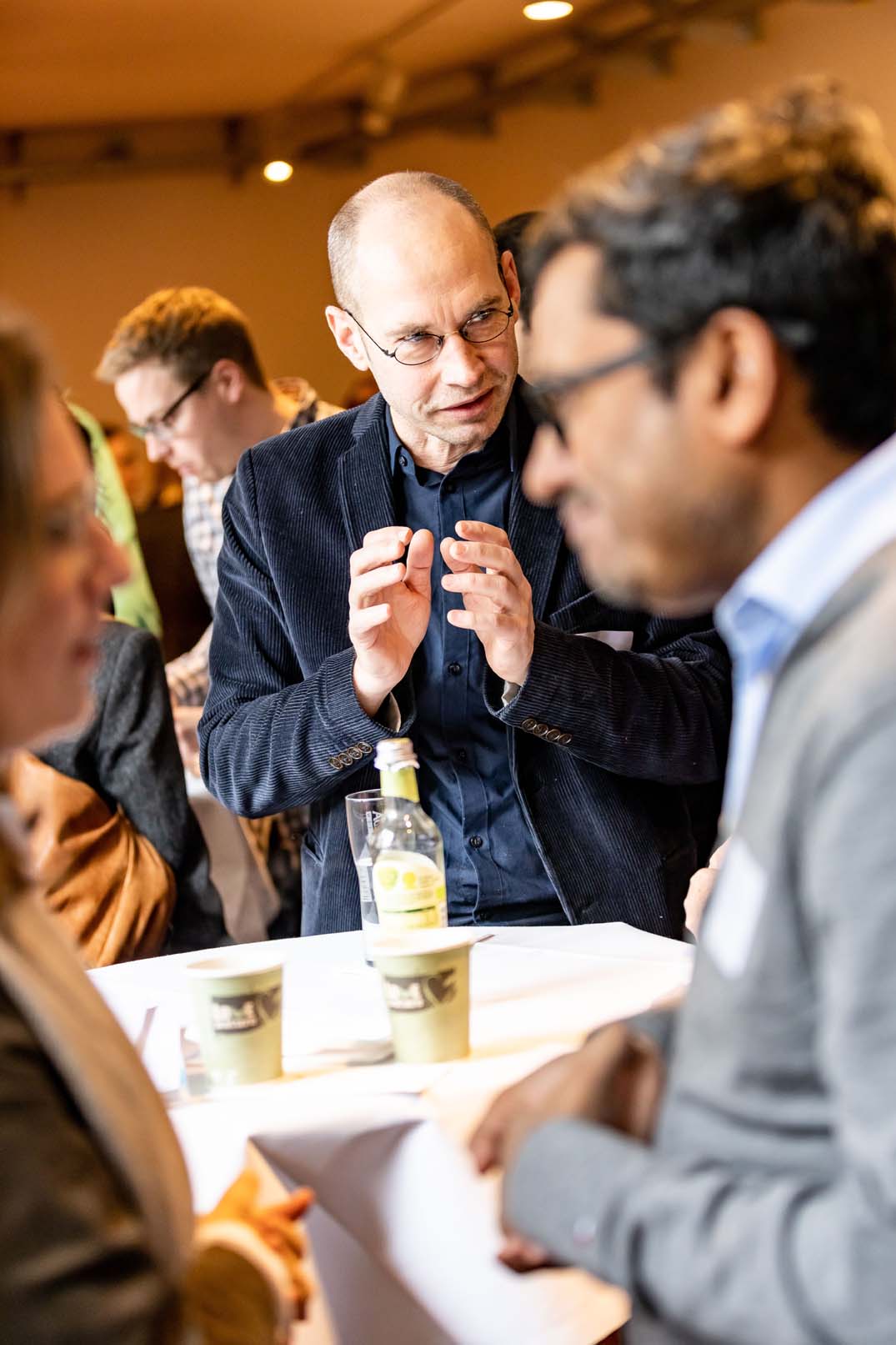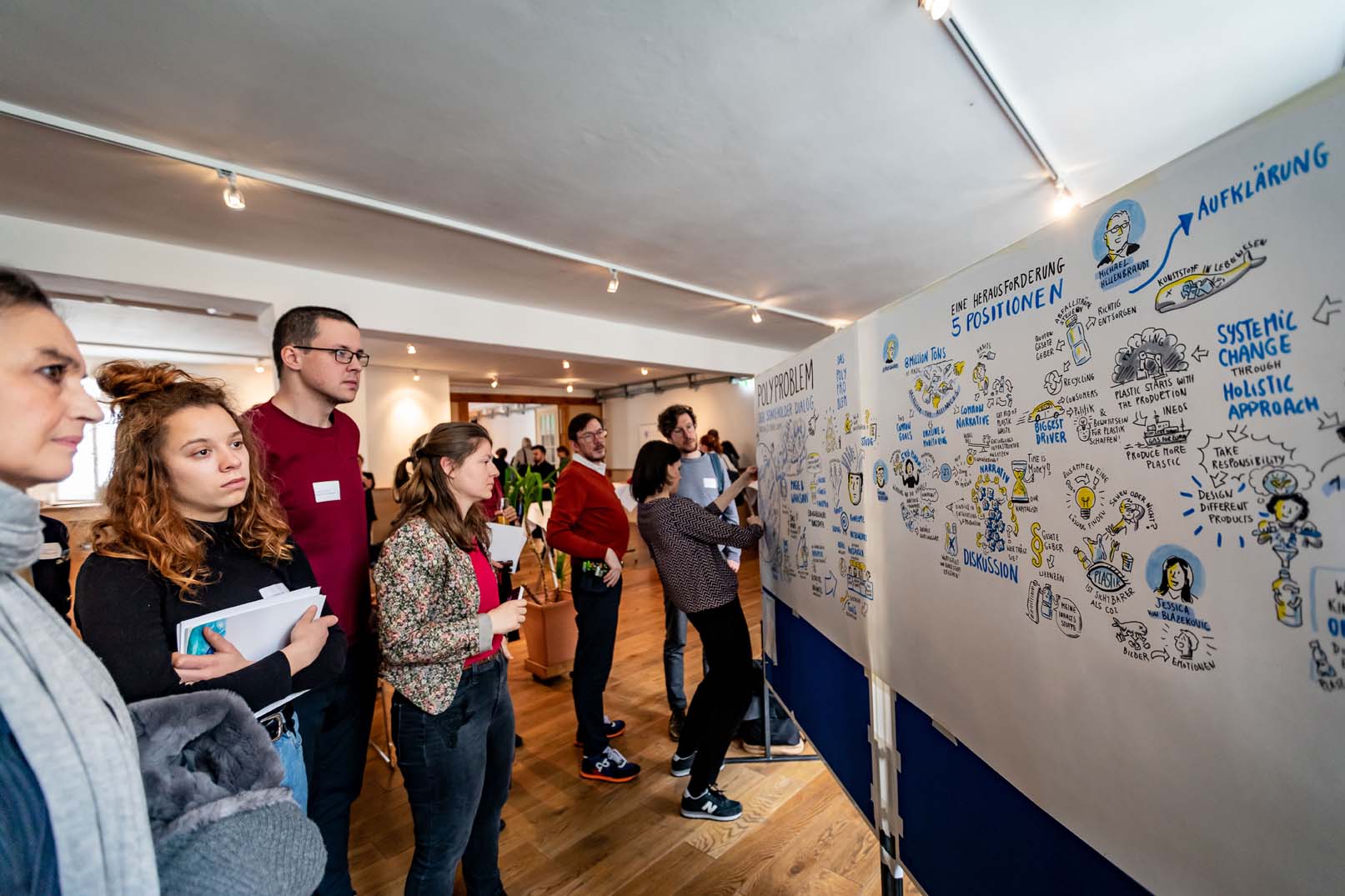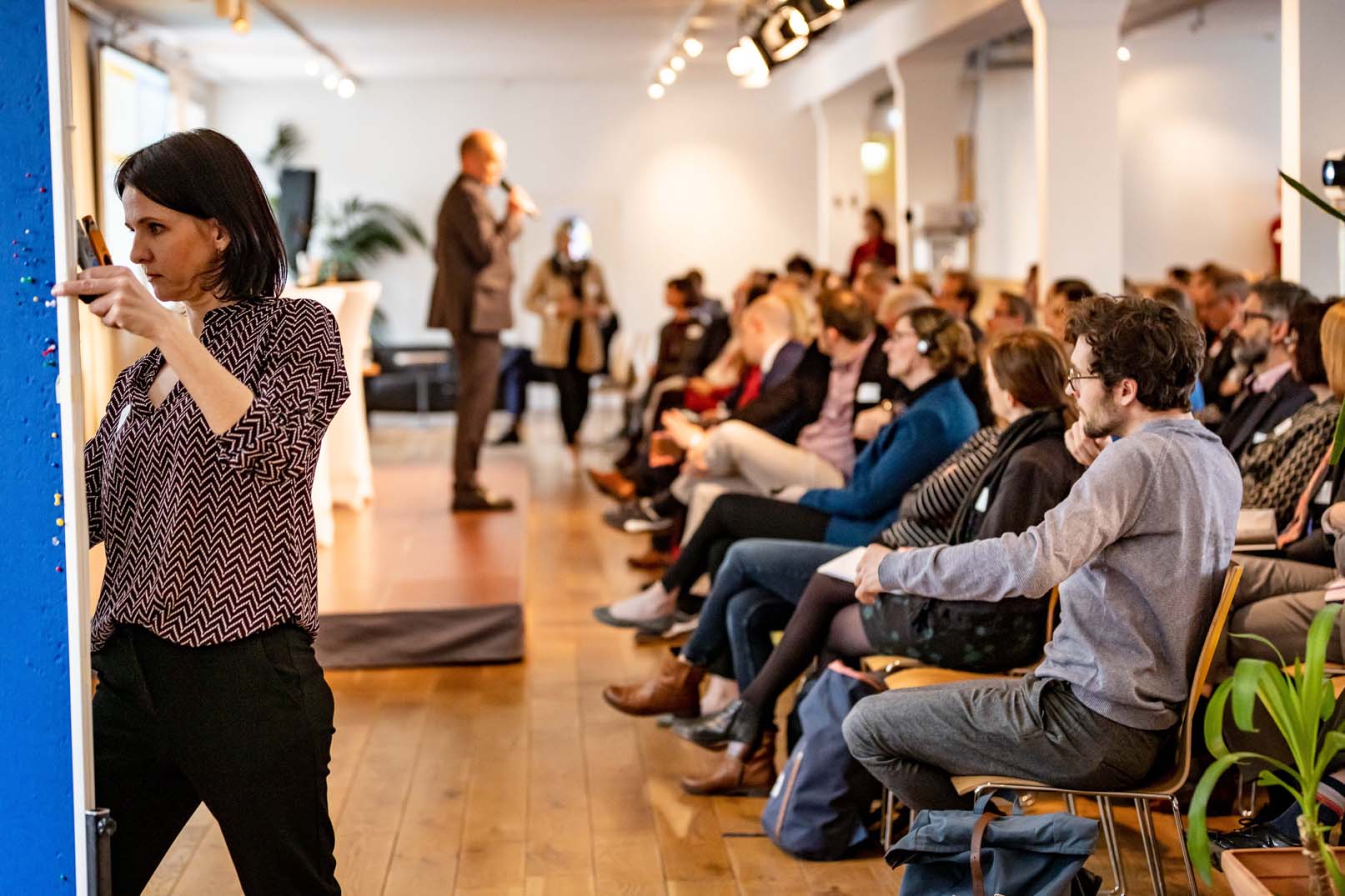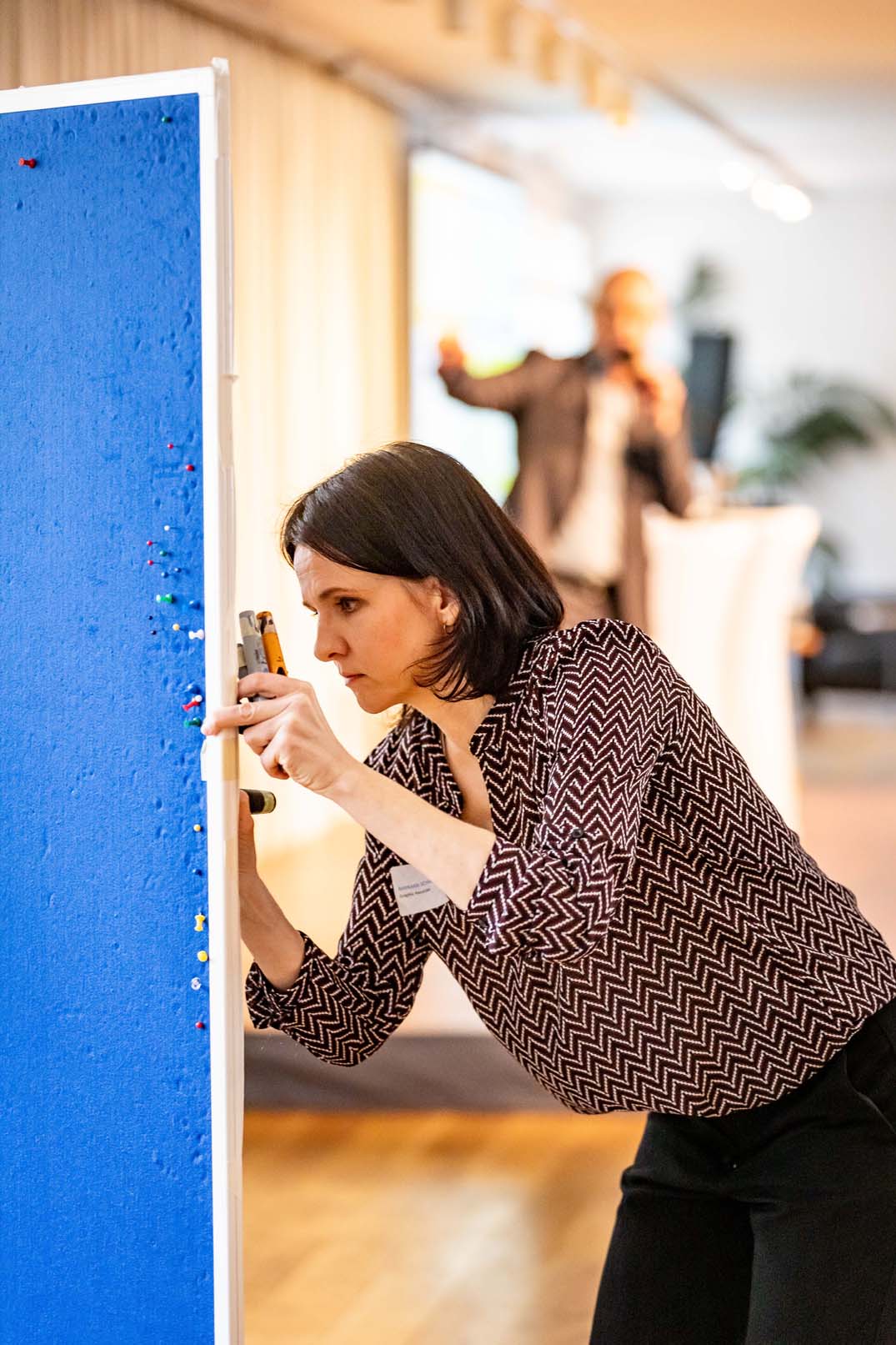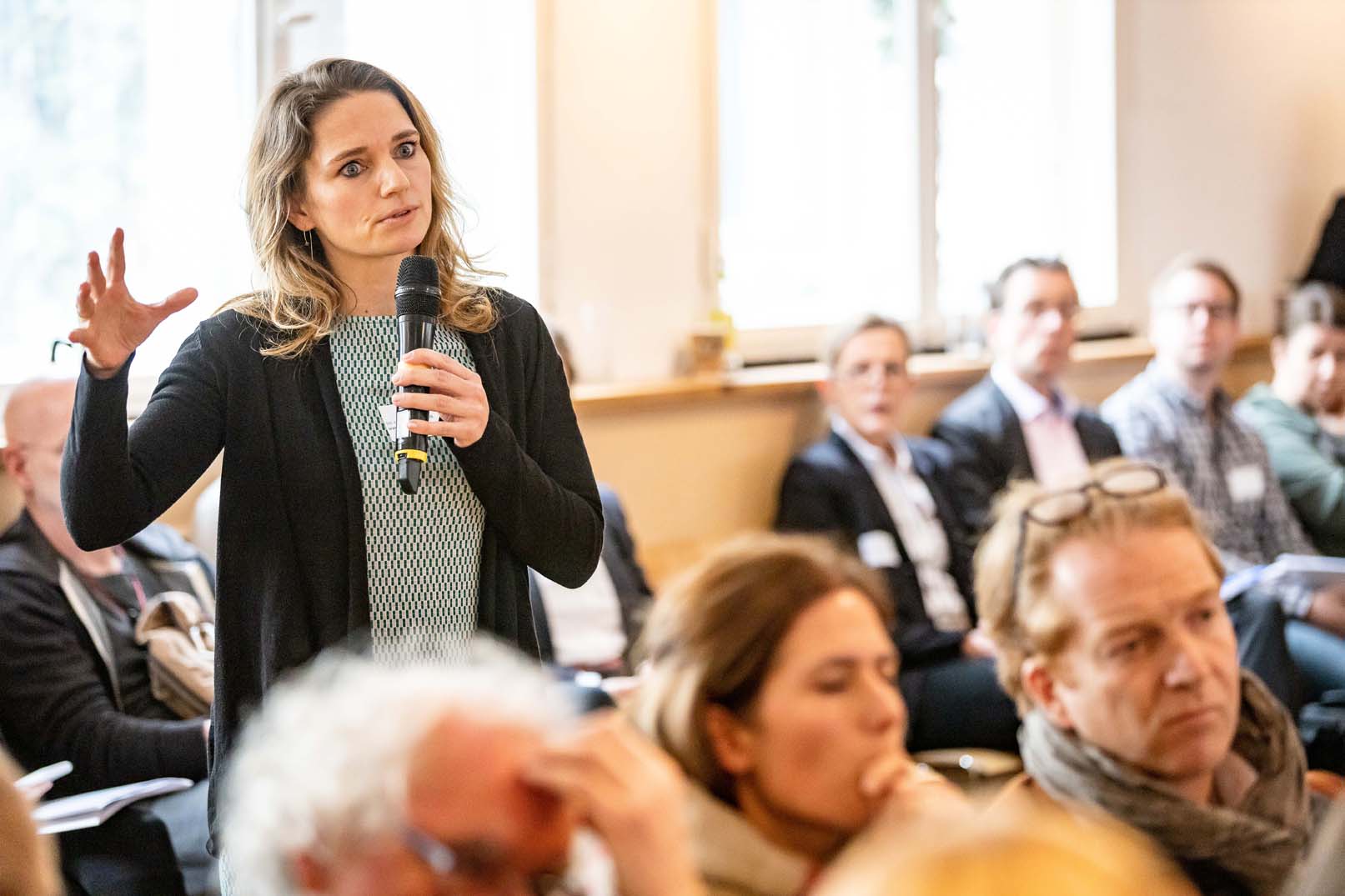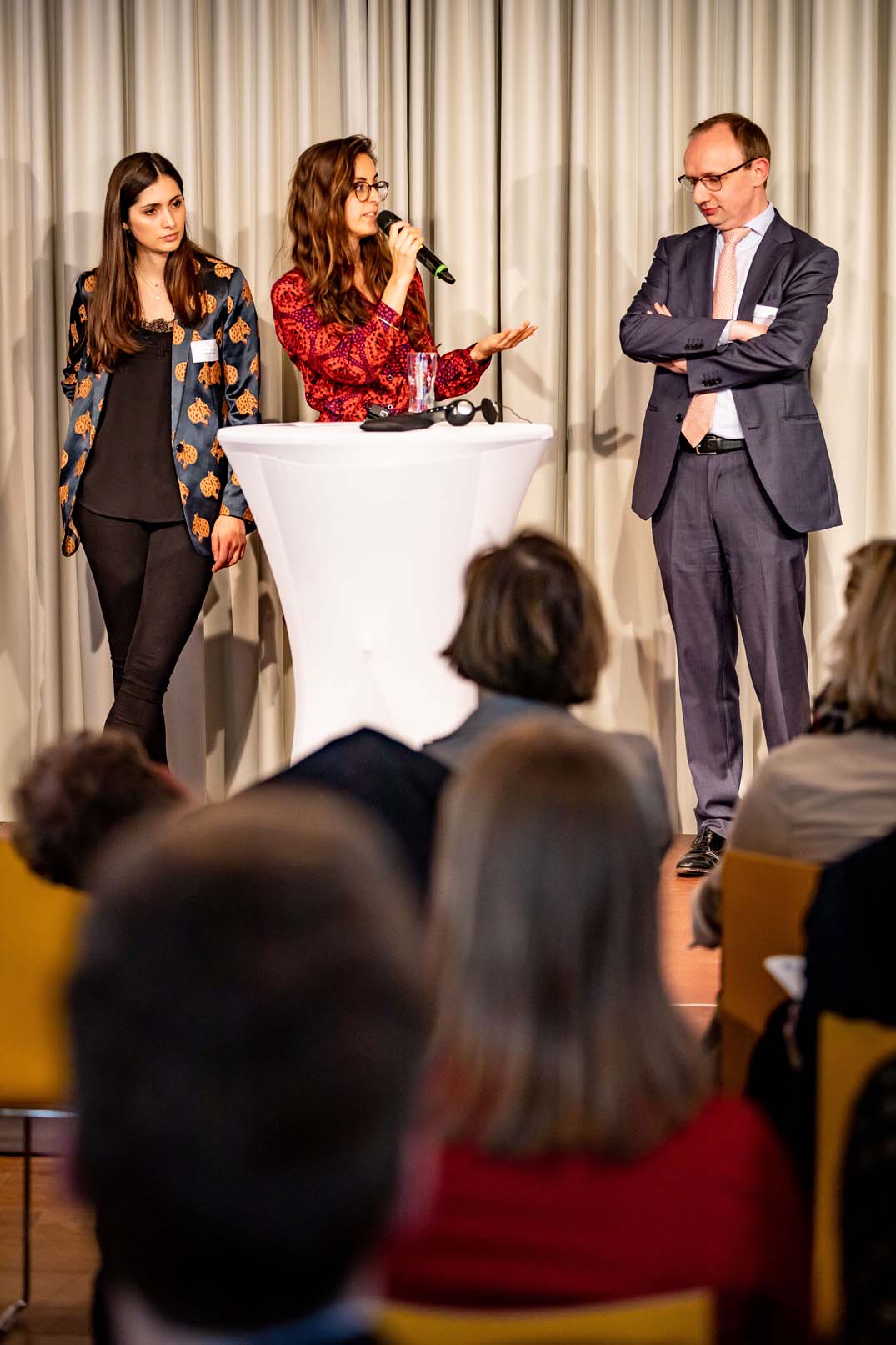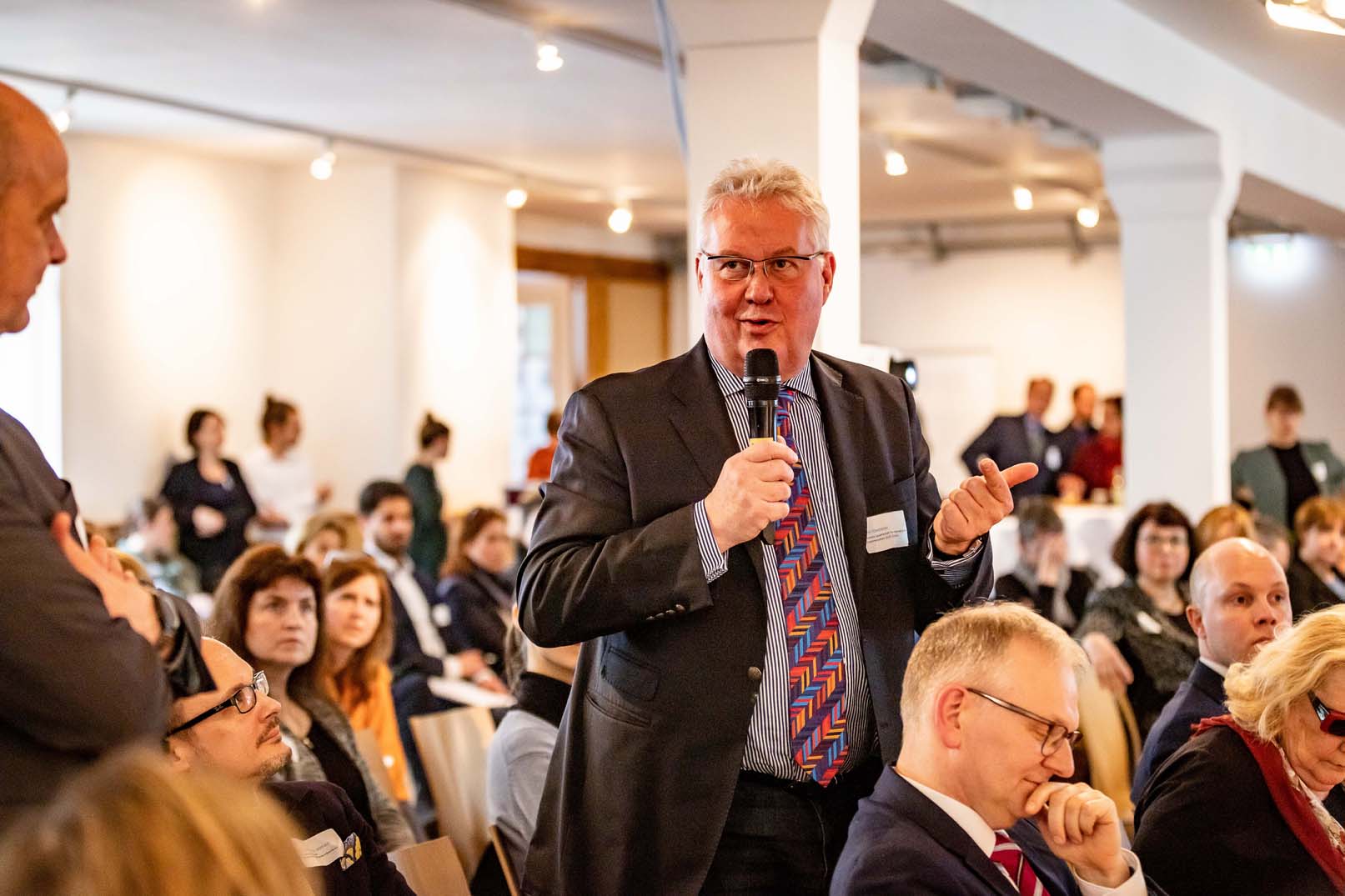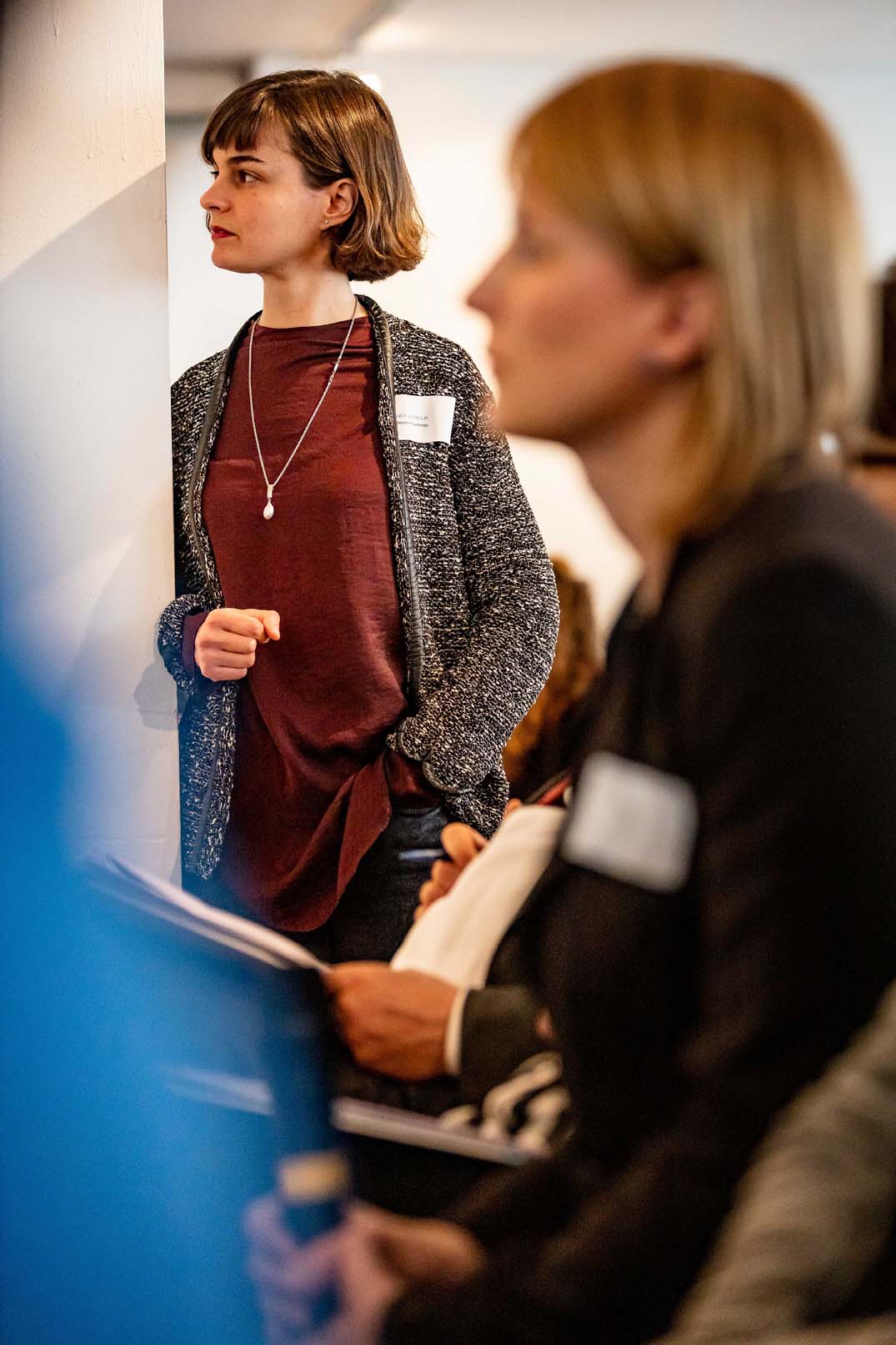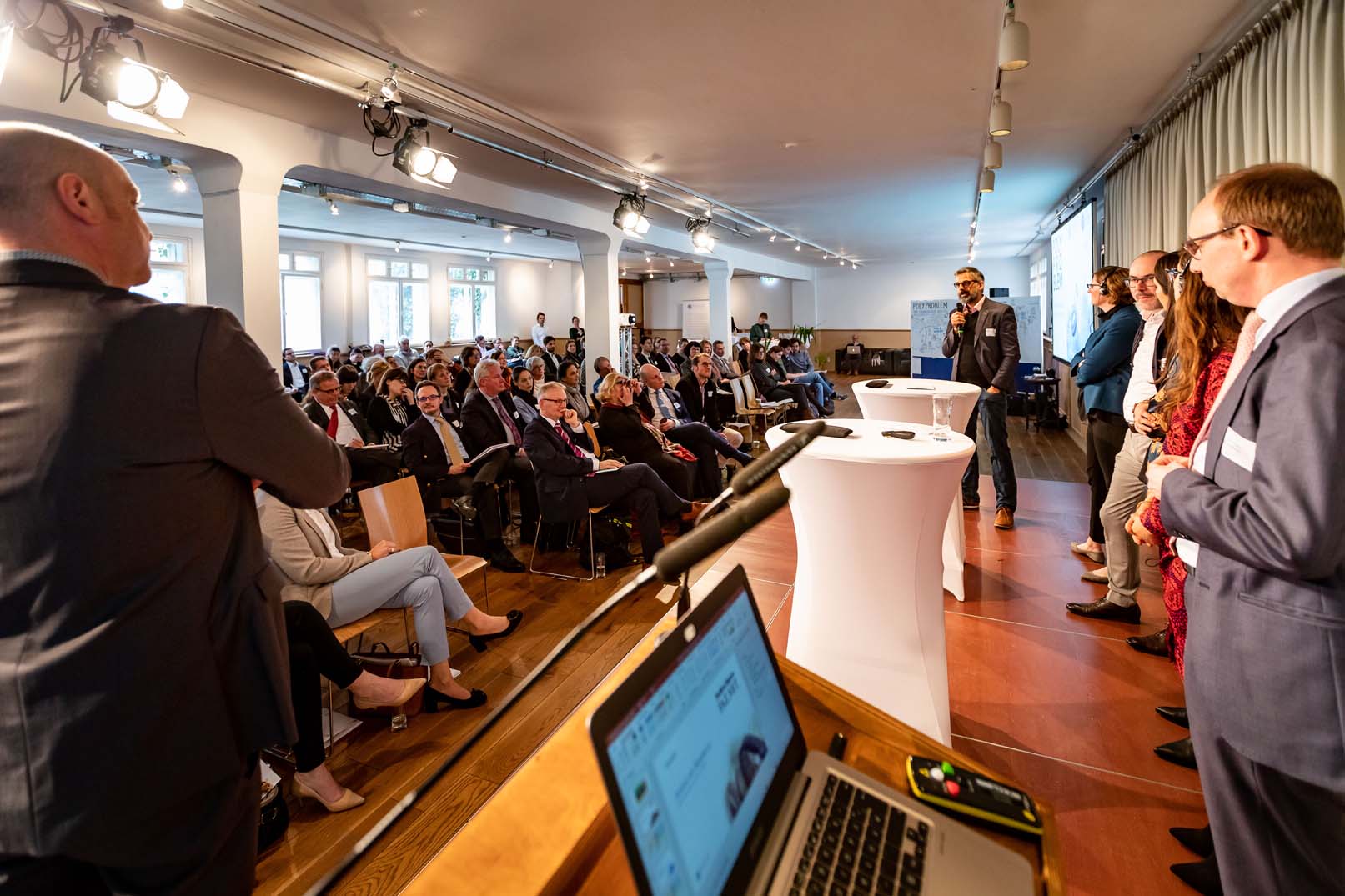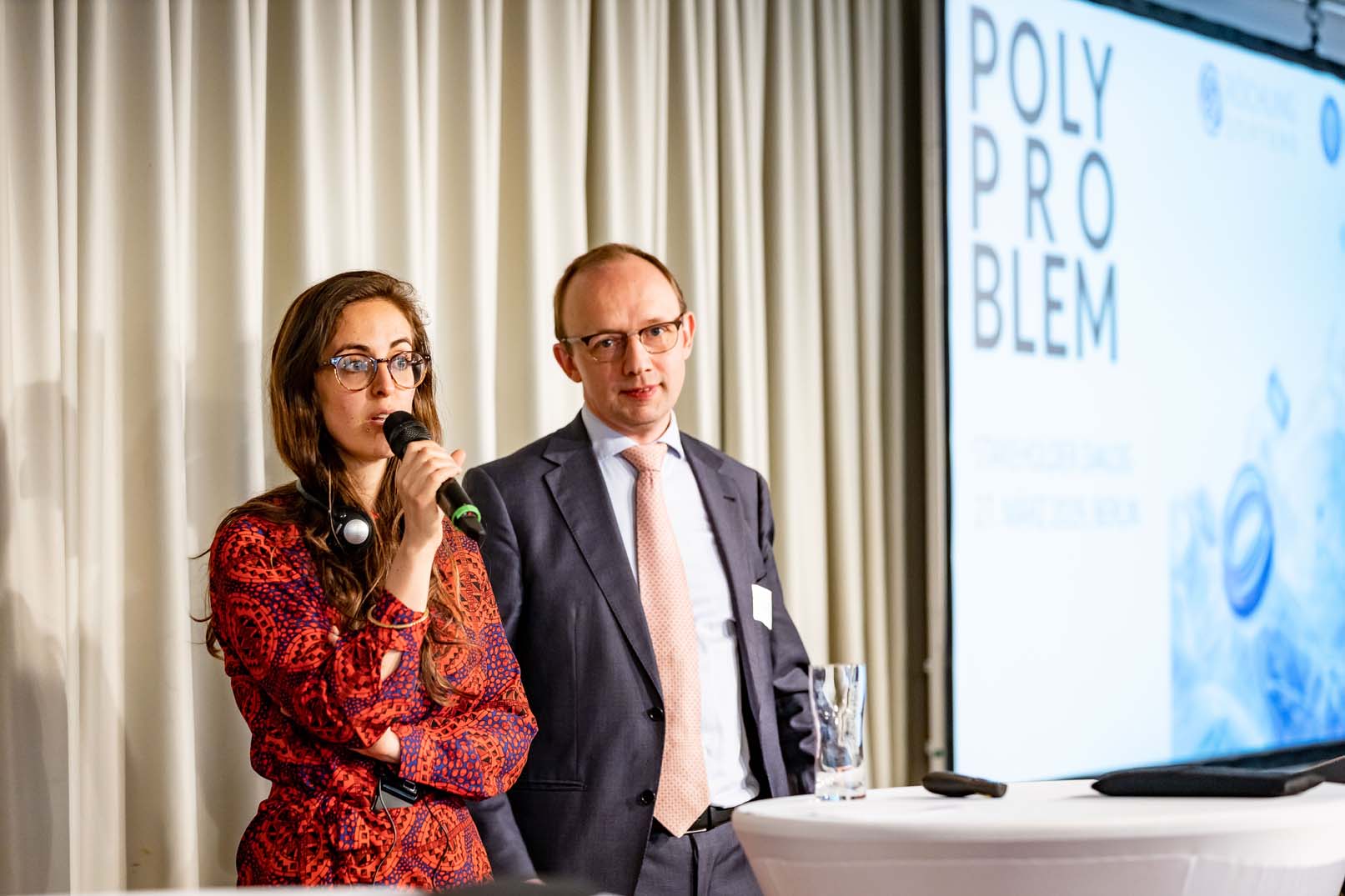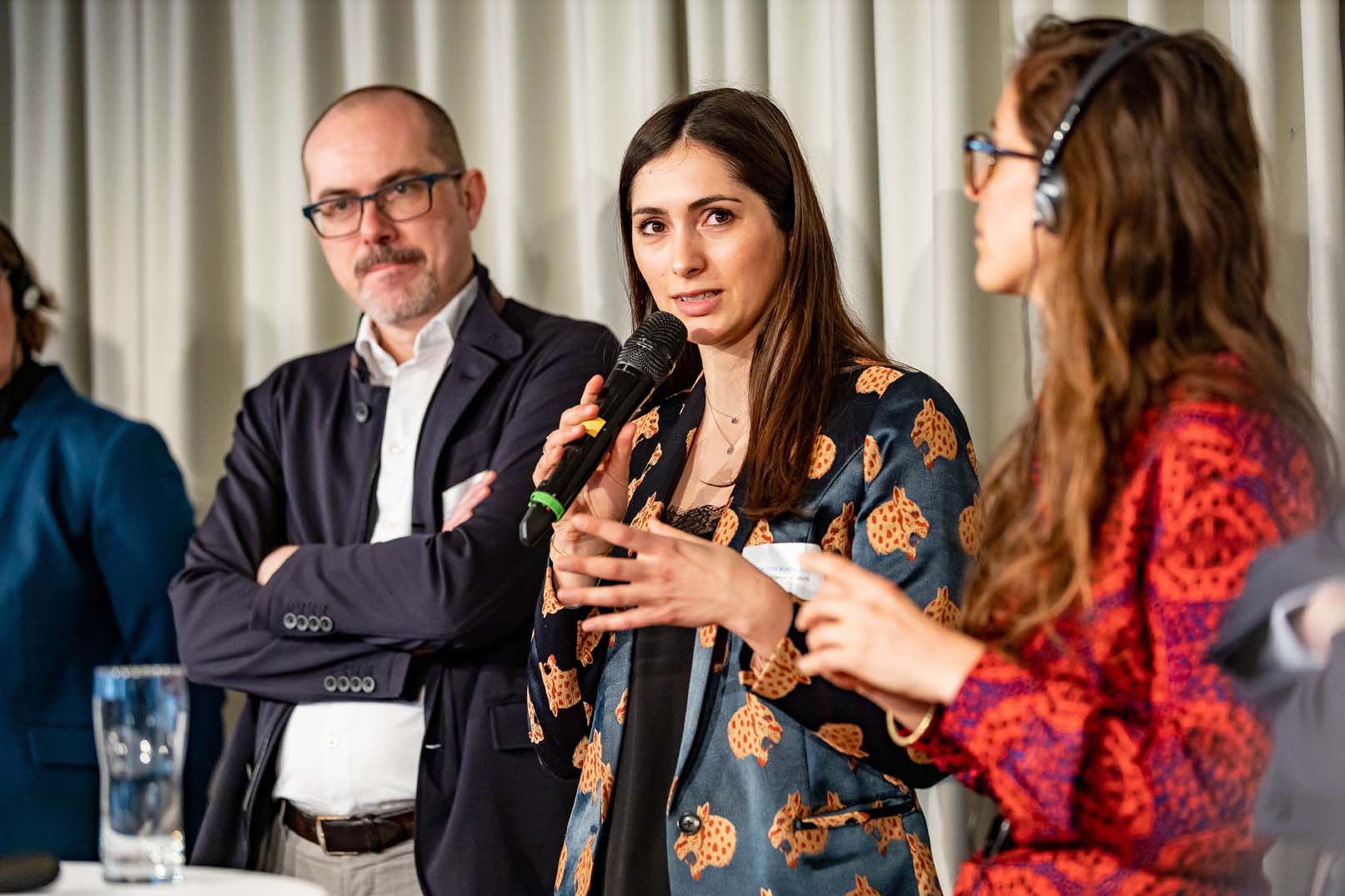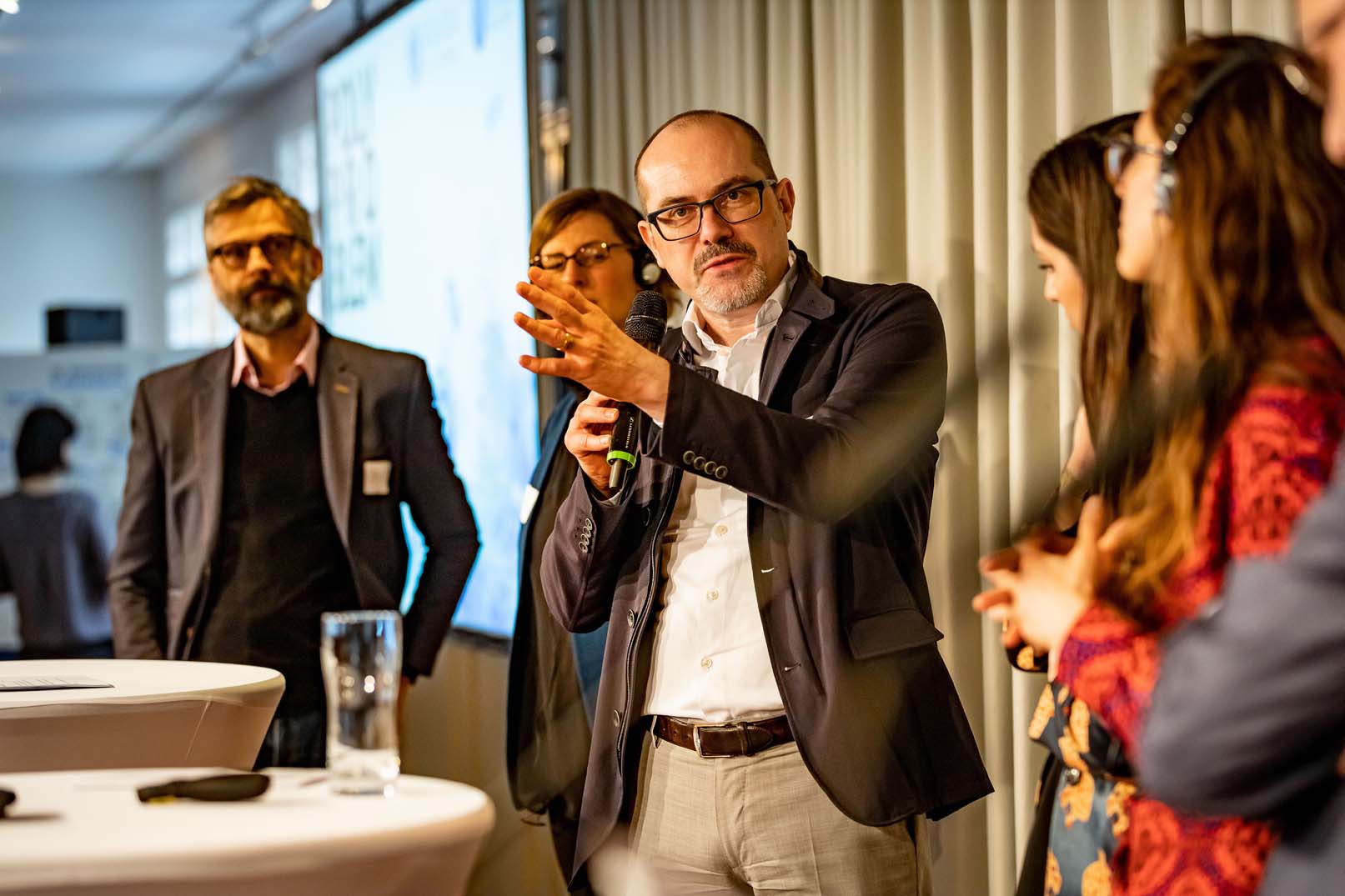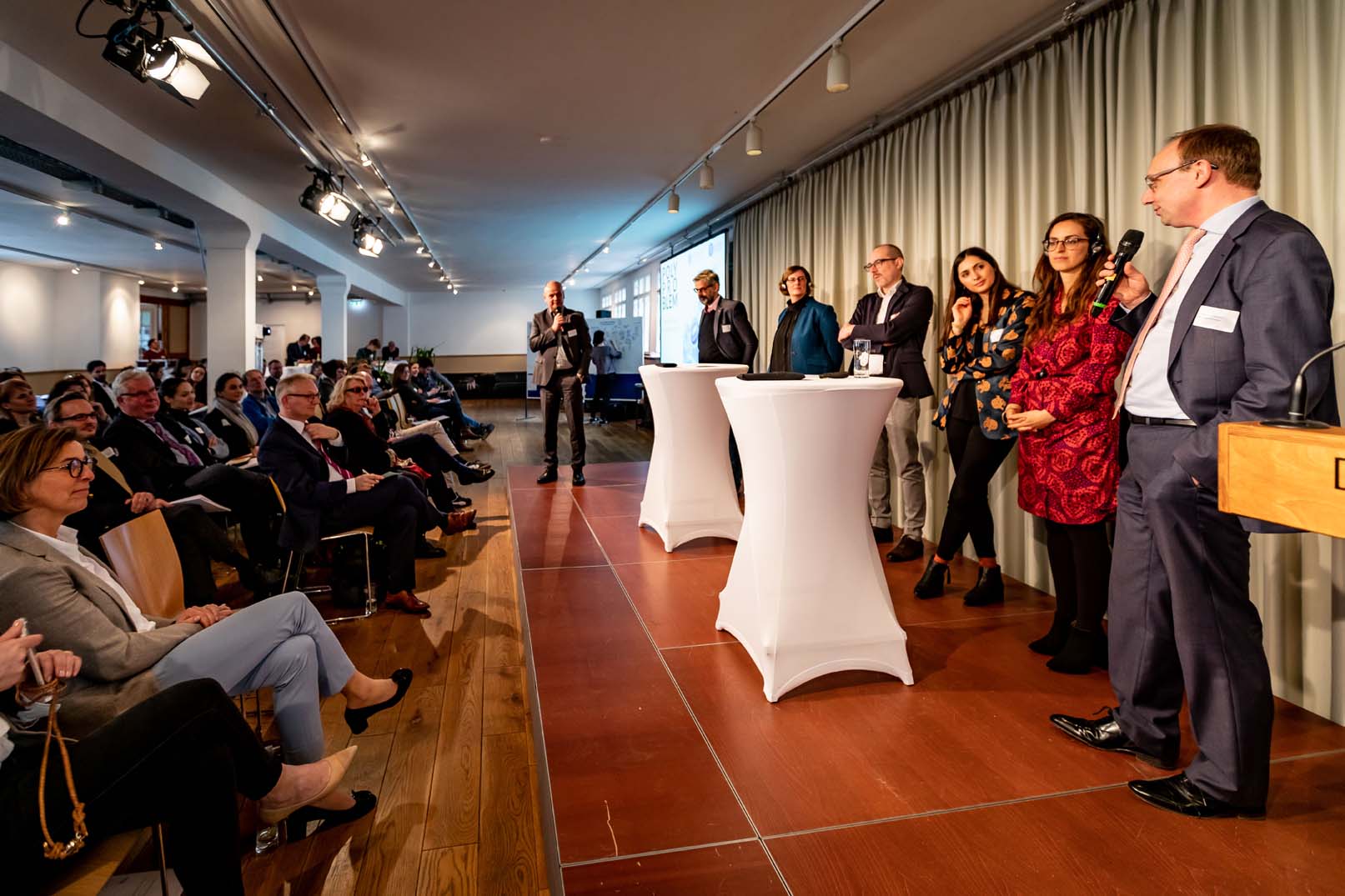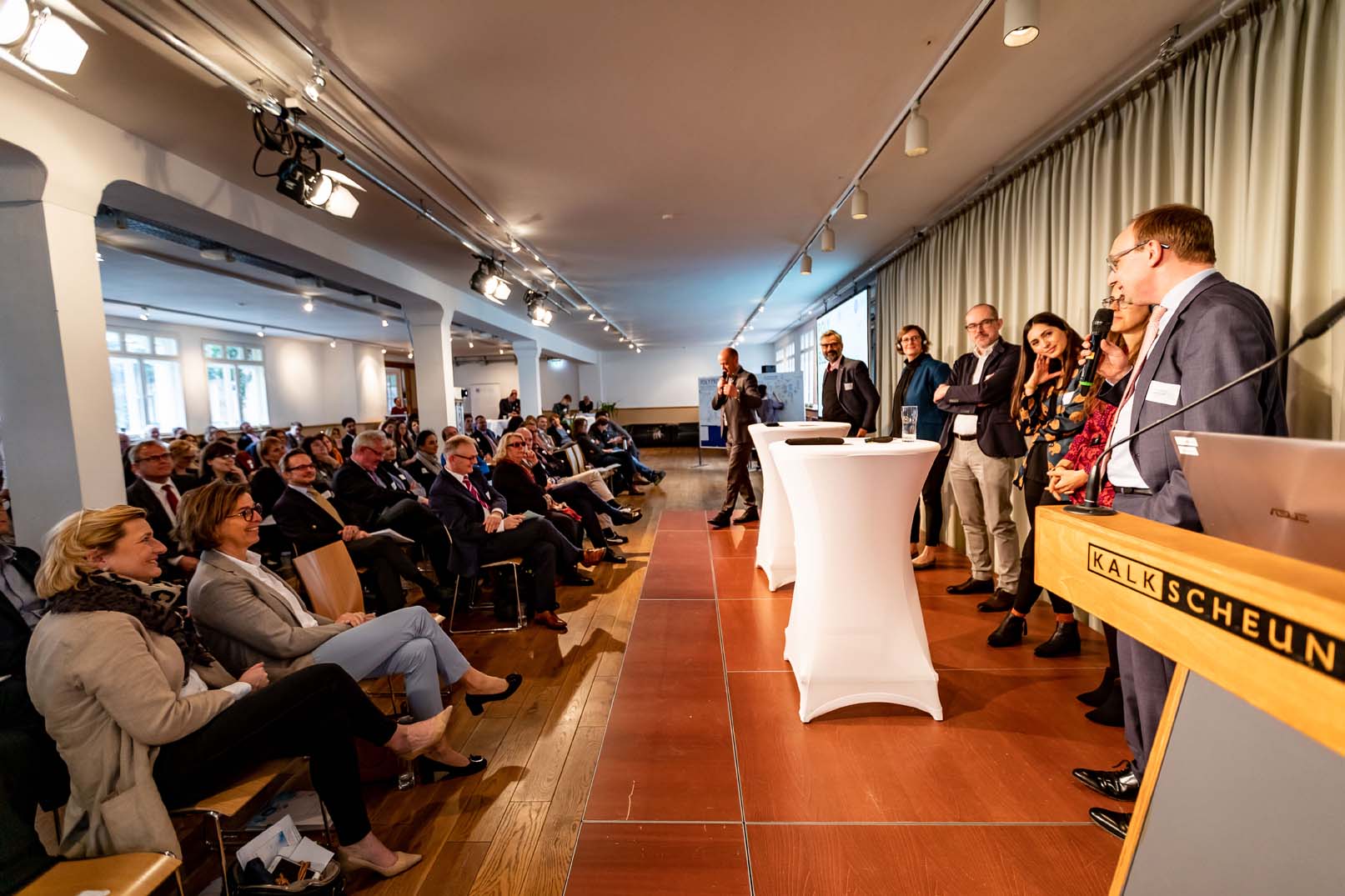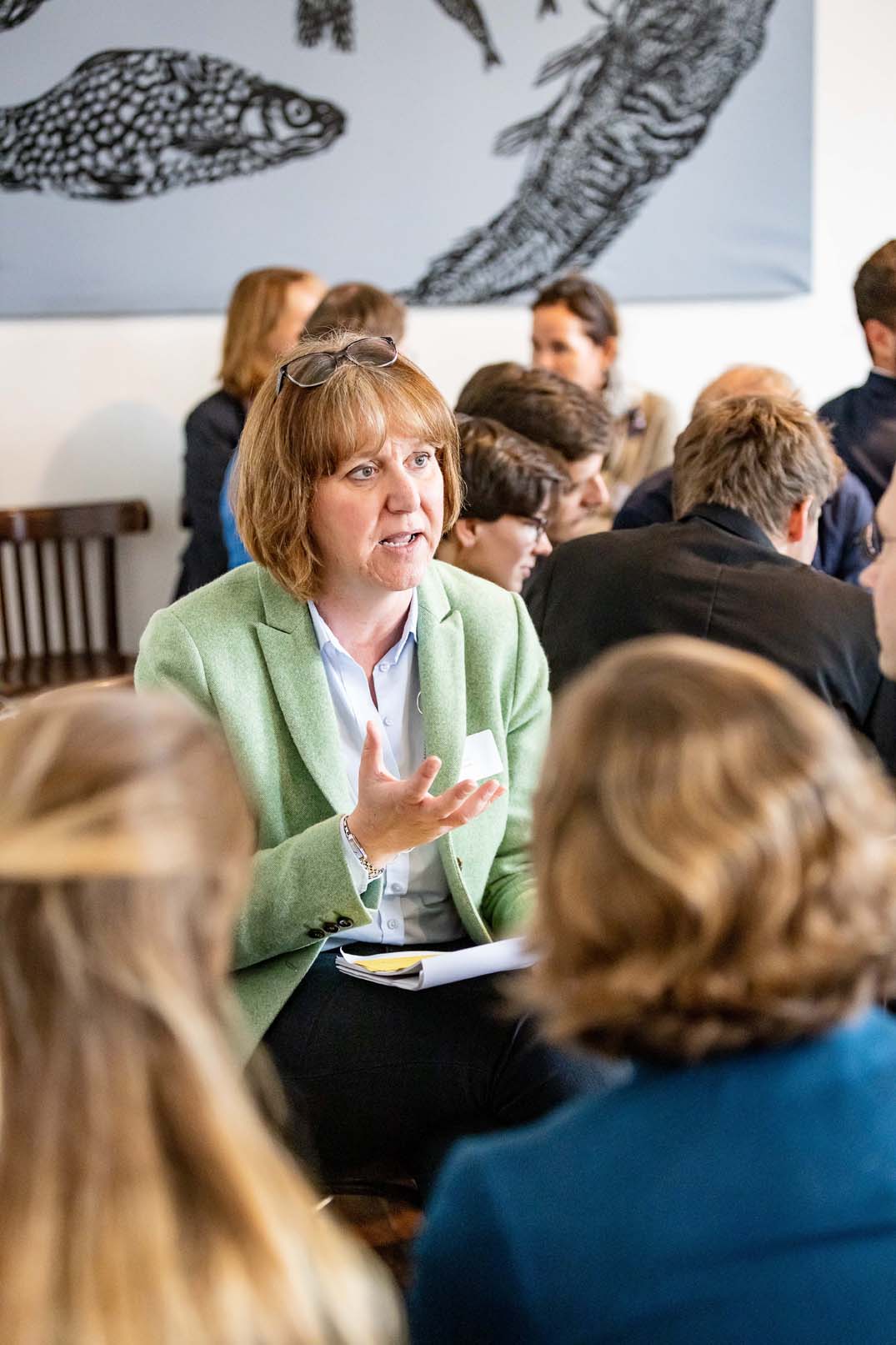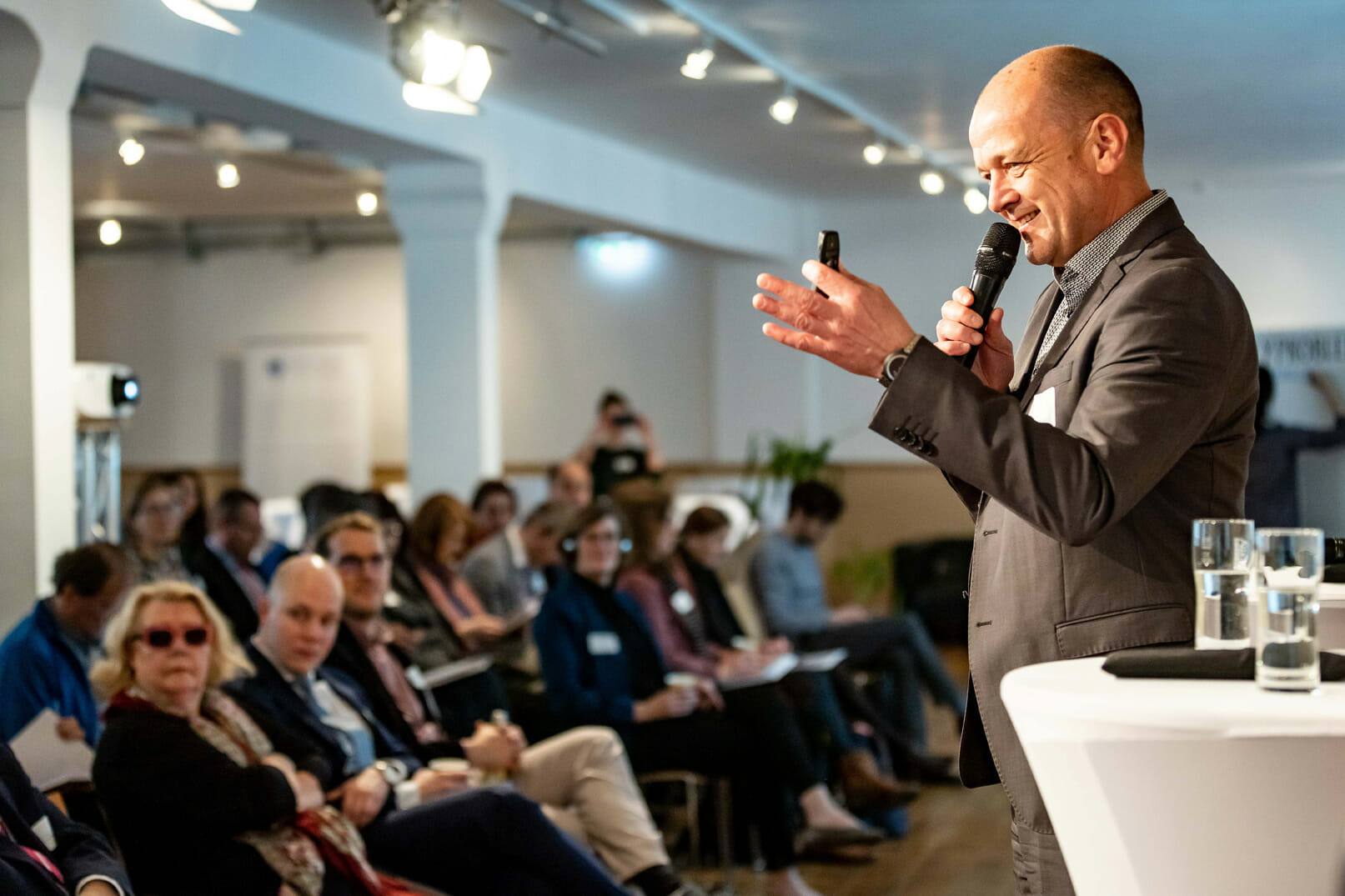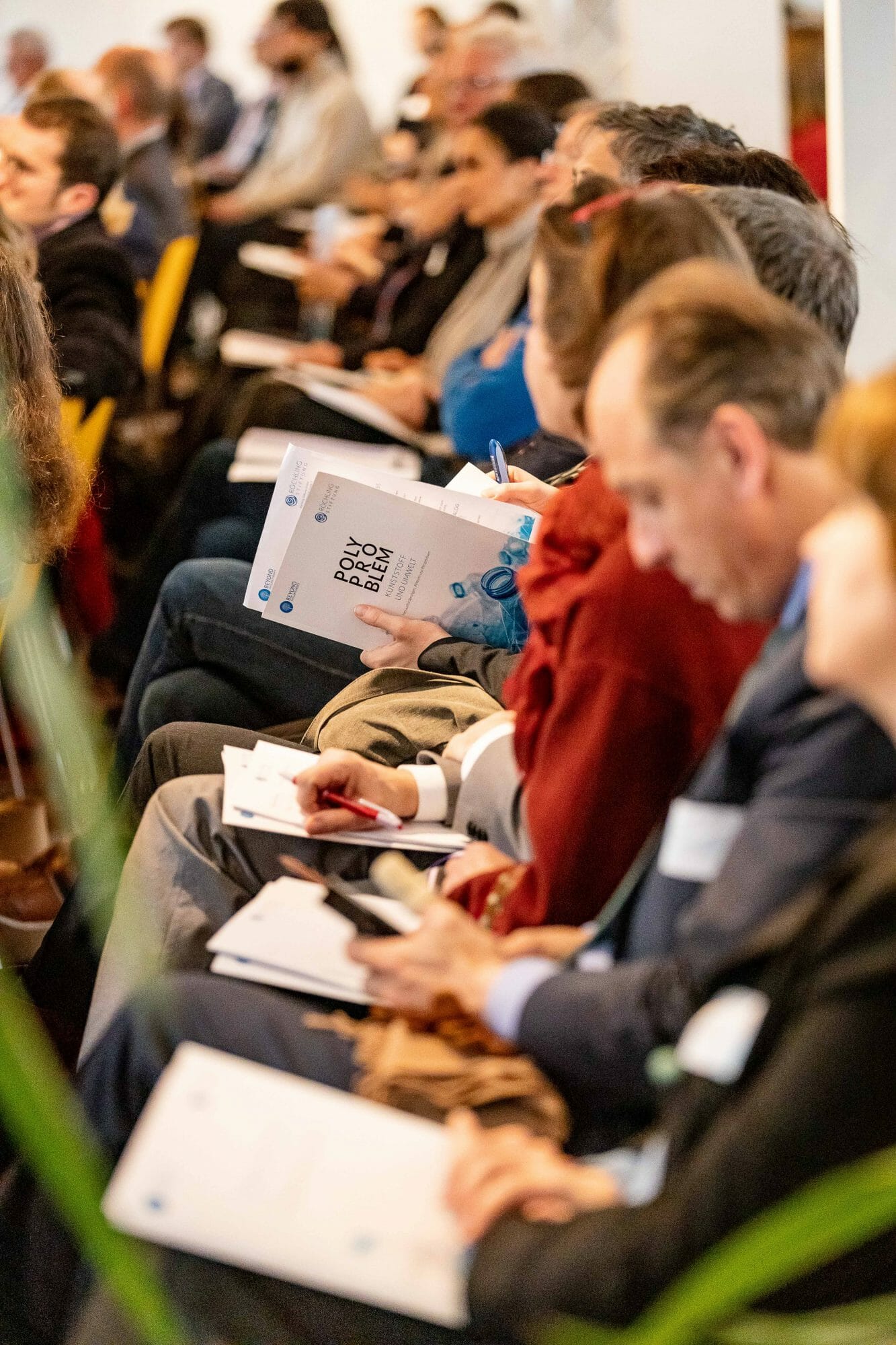
POLYPROBLEM – The Stakeholder Dialogue
Joining forces. Developing solutions together vs. launching individual projects. Combining the possibilities of business, science and civil society. Guided by the concept of Collective Impact, some 150 experts met at the invitation of Wider Sense (formerly Beyond Philanthropy) and the Röchling Foundation in Berlin, this March. The response to this event exceeded all expectations.
Uwe Amrhein, Foundation Manager of the Röchling Foundation warmly welcomed all guests from politics, foundations, education and industry as comrades-in-arms, revealing the major aim of this event: Namely, bringing together structured ideas on how to approach a solution to the POLYPROBLEM of plastic and environment in a first step, followed by the aim to sediment first ideas for joint formats, tools and places all in style of the greater concept of Collective Impact.
Uwe Amrhein welcoming the #stakeholders at our dialogue #plastic and #environment, #POLYPROBLEM @BePhilanthropy pic.twitter.com/ViM12fSCB8
With his lecture on The Age of Plastics, Dr. Franz Mauelshagen from the University of Duisburg, Center of Global Cooperation Research gave a historic head start into the day. He highlighted the history of an artificial material whose global distribution has become symbolic of an anthropocene – an age in which mankind has become a relevant factor for biological, geological and atmospheric processes.
Magic and Madness – The Age of Plastic
Already in the 1930s, plastic was known as an epoch-making material to scientists and chemists. Meanwhile, scientific thoughts even go so far as to regard plastic as strategic markers, since their existence in sediments will be verifiable for centuries or even millennia.
The controversial history of plastic began with the development of polymers in 1900.
Our keynote speaker @FMauelshagen: “the growth of #plastic is far beyond economic developments”, the success story that comes with a history of generating problems #environment #POLYPROBLEM pic.twitter.com/thAJ31lKt8
Product diversification and differentiated applications increased from 1940 to the 1980s. Biopolymers have been on the scene since 1990. Recognizable accumulation in the environment has been observed since the 1960s and was already perceived as a problem at that time.
@FMauelshagen on the problems of #plastic: our “throwaway” community is just one of the many reasons for the cumulation of plastics in our #environment. #POLYPROBLEM @BePhilanthropy pic.twitter.com/fcOZIdsdym
The problematic success of plastic as a material began its impressive growth of 8.4 percent on average at the end of WWII. The trend remains unbroken to this day. Thus, the growth of this material far exceeds the general economic development.
In the meantime, consumer historians have identified the throwaway society as the social anchor of accumulation. This development is based on a dynamic pattern that reinforces growth.
- Diversification of the plastic material
- Increased applications and plastic products
- Increased growth
The historian concludes: “It is precisely this dynamic that will be necessary in solving the problem. The key question is: How do we make this dynamic smarter?
The POLYPROBLEM
Annunziata Gräfin Hoensbroech, Chairwoman of the Board of Trustees of the Röchling Foundation, and Michael Alberg-Seberich, Managing Director of Wider Sense, articulate the operative and emotive field of tension of the plastic problem in a POLYPROBLEM outline.
Gräfin Hoensbroech & Michael Albert-Seberich on the beginnings of & reasons for our policy paper #POLYPROBLEM that led to today’s #stakeholder #dialogue: creating a platform for connecting people, creating an overview on #plastic+#environment, acting towards collective projects. pic.twitter.com/xsd8MTjNfo
Resignation, loss of power and institutional disorientation face financial resources, whose effective use is still unclear. Question is: On what grounds is an investment useful?
- in sustainable material cycles,
- in raising consumer awareness,
- in political initiatives?
The first scientific step of the Röchling Foundation had been the study POLYPROBLEM, developed and performed by Wider Sense. It all began with the desire for a common national and international agenda. Additionally, the need for transparency on different approaches and strategies became obvious. The approach on solving the POLYPROBLEM: it is inevitable that from the beginning, all players and partners have to be and stay on the same page. They commonly have to have the same understanding of data situations and joint actions, as well as include a fixed exchange format for different networks and alliances. The POLYPROBLEM Stakeholder Dialogue therefore explicitly looks for possibilities, not for exclusion criteria – it is the chance for a comprehensive cooperation management.
One Challenge, Five Positions
Emily Woglom, Executive Vice President, Ocean Conservancy
Proposition:
We need a middle ground between competition and isolation as well as between alignment and coordination.
We still lack a common polyproblem narrative, we lack common goals.
Common goals are available for CO2, however, not yet for plastic. Global monitoring and data collection are equally incomplete.
Jürgen Bertling, Chemical Engineer, Fraunhofer UMSICHT
Proposition 1:
We need a new emission class for plastic – labeled: very, very persistent
Every year, the average German citizen releases about 5.4 kg of plastic. One quarter of this being macroplastic, three quarters microplastic. Mircoplastic is caused by abrasion and weathering, washing, by paint or tire abrasion. Polymers are the biggest health problem.
Jürgen Bertling @plastikbudget on #circulareconomy, #polymers + #microplastics. “The degradation of #plastic happens very slowly. The ‘dangerous substance’ level is ‘very very persistent’.” pic.twitter.com/yRQSJtHjgo
Proposition 2:
We need a budget on plastic emission.
Its goal must be to preserve the status quo of plastic emission, not further tighten it. The highest level may not exceed 200g of released plastic per capita per year.
This entails a reduction by factor 27. However, this can only be exercised by issuing bans of certain products, by the recuperation of plastic, as well as by an improved degradability and incentives for industry.
Michael Hillenbrand, Plastics Europe Germany
Proposition 1:
In Germany, waste stream systems ensure that no plastic ends up in the environment.
The separation of household waste enables a recycling progress.
In addition, legislators have tightened product and manufacturer responsibility by law.
Michael Hillenbrand @PlasticsEuropeD: “In Germany, there is no reason for #plastic to land in our #environment – but still, it does.” #circulareconomy #POLYPROBLEM @BePhilanthropy pic.twitter.com/gUd5KywOxF
Proposition 2:
We need investments in existing processes and innovations.
To fight the global problem, we need tailor-made regional solutions.
Delphine Lévy Alvarès, Zero Waste Europe
Proposition:
We need coordinated action by NGOs in order to make a plastic waste free ocean a dream come true.
Change is keyword in order to achieve this goal!
- Change of the dominant, unsustainable narrative.
- Change of the entrepreneurial activity (petrochemical industry as the originator of the problem, the big consumer brands as their main disseminators).
- Change into Zero Waste Cities.
- Change of the created dependence on cheap plastic.
- Change of the imbalant investment in plastic.
- Change of plastic exports to developing countries.
- Change in Europe’s own responsibility.
- Change in consumer behavior in regard to recycling, reusable packaging or free water stations.
@delphinelevialv (@zerowasteeurope) on their learnings from #zerowaste project & #BreakFreeFromPlastic: “Products distributed in the market do not fit the waste management systems.” pic.twitter.com/nfOdPSfMiu
Jessica von Blazekovic, business editor at FAZ.net
Proposition 1:
It is a good thing that plastic shows up everywhere.
The picture of the whale with 40 kg of plastic in his belly is visible, the numbers are huge.
The Great Pacific Garbage Pad is three times bigger than France. The reason for the disaster clearly are manufacturers and people.
While climate change is still struggling for recognition, the facts of plastic pollution are obvious.
@jvblazekovic (@faznet) bringing in the journalistic point of you to the dialogue: “#Plastic has a good aspect other environmental problems don’t: it is visible. And so are the waste producers and effects. This is a silver lining.” #POLYPROBLEM #environment @BePhilanthropy pic.twitter.com/kmBRYYk9UK
Proposition 2:
This topic must be regarded by the media. However, without endangering its joker.
Topics on plastic are of high awareness. However, there still is resentment against bans of certain produce. Thus, an emotional debate divides the camps. Politics, media, consumers and companies must find a common solution.
Everybody is aware of the problem, no one can deny it.
The Debate
The following debate circled around diffuse responsibilities and the recognition that polyproblem does not only need a so-called polyresponsibility but even more so political guidance. Some of the actors, fields of action and approaches listed in the polyproblem study were reflected in the subsequent discussion. These included optimized recycling management, recycling, upcycling, alternative materials or changes in action.
Open for questions from the audience: #stakeholders discussing with stakeholders. Ideas and impulses for collective actions being discussed and created, #plastic + #environment. #POLYPROBLEM @BePhilanthropy pic.twitter.com/LhAA0RzF2U
The open, yet critical discussion made it clear that learned mechanisms in the field of plastic are no longer enough. The principle of responsibility of the petrochemical and packaging industry will also play a major role, as well as the product designers who develop new products and eventually each individual consumer who ultimately is in realization of the said emissions.
The visibility of the problem must not be prematurely divided into camps and be bypassed by emotional, medially heated discussions. The truth lies somewhere in between the propaganda of simple solutions and the denial of the problem itself. Polyproblem needs Polyvox.
The Workshops
On site, the event and the workshops were graphically escorted by the artists Barbara Schneider, Julian Kücklich and Sebastian Lötscher. (www.creativetribe.eu).
POLYCHANGE

POLYPROBLEM: The stakeholder dialogue on plastic and the environment by Röchling Foundation and Wider Sense
On the Way to a Common Goal
The challenge of plastic and the environment is very complex. This makes it difficult for organizations to set right priorities and manage their interventions effectively. It seems even more difficult to develop a global agenda from the different approaches to action – recycling management and recycling, prevention and elimination.
The two workshops POLYCHANGE offered its participants the opportunity to inform themselves about the Theory of Change and immediately dive in the mutual sketching and discussing.
The Theory of Change describes a systematic project planning process as well as a specific form of impact model, which is in fact the product of this process. The basic idea is to determine which prerequisites the project must create in order to achieve these impact goals. All based on an overarching goal which had been mutually formulated prior to this process.
More Information on the Theory of Change?
Get to know the Basics of the Theory of Change.
Read here about the United Nations Development Group experiences with Theory of Change.
Huge Commitment but no Common Agenda
The jointly formulated goal of the first POLYCHANGE studio was quickly developed, as the participants wanted to stop the harmful plastic emissions into the environment and agreed upon the slogan no plastic waste in the environment as the overriding goal in a Theory of Change. The immediate preconditions evaluate as: first, the disposal of plastic waste in the environment and second, the unrestricted avoidance of new plastic waste being introduced.
During the discussion on the avoidance of new plastic waste being introduced into the environment, it was commonly agreed upon the fact that this goal cannot be achieved without the introduction of a circular economy and the reduction of the product to the necessary areas of use. The discussion concluded with the question for the precondition of a solid ecological overall assessment of plastic products. While the change in consumer behavior is considered necessary, it is not least the lack of incentive structures for this change in behavior that is mentioned as part of the problem.
The Challenge – Be Part of the Solution!
The second POLYCHANGE studio focused on the interplay of consumers and producers with the question “How do we achieve that both consumers and producers become more sensitive to the topic of plastics and change their behaviour?” The sustainable development of awareness in childhood as well as economic regulation by means of financial incentives, were seen as immediate preconditions for this.
For both, there is currently a lack of suitable platforms for information, exchange and action. The formation of an international World Plastic Council – just like the Intergovernmental Panel on Climate Change – is seen as an opportunity to bundle interest and action.
Who Does What?
The idea to continue working more intensively on the Theory of Change was very well received by all participants. In a two-day workshop, not only the complexity of the subject area was being layered, but also the definition of responsibilities and competencies as well as the exchange of resources and budgets was being worked on.
More detailed information on an in-depth Theory of Change workshop will follow shortly.
The Way to Collective Impact
It was revealed by the two POLYCHANGE Studios that there is a strong need for a common agenda to avoid plastic waste in the environment. Short-term and widespread funding of specific projects cannot be a solution to the problem. It is that these project focus on short-term and exemplary measures rather than on sustainability. Moreover, such an approach usually only has an isolated effect. In order to achieve a collective effect, a different kind of cooperation is needed. The Collective Impact method offers a solution to this problem. It served as the main subject of the POLYFORMAT and POLYTOOLS studios’ stakeholder dialogue.
POLYFORMAT AND POLYTOOLS

POLYPROBLEM: The stakeholder Dialogue on Plastic and the Environment. Röchling Foundation and Wider Sense, Photo credit: Jörg Farys

POLYPROBLEM: The stakeholder Dialogue on Plastic and the Environment. Röchling Foundation and Wider Sense, Photo credit: Jörg Farys
The studios POLYFORMAT and POLYTOOLS were the result of a preliminary online survey prior to the stakeholder dialogue. The participants were asked about their needs and expectations. The participants expressed their wish for a platform for exchange, networking and cooperation as well as the matching of resources and expertise. How this can play out and what is needed was subject of the studios POLYFORMAT and POLYTOOLS.
5 Conditions for Success
Collective Impact offers the opportunity to successfully work together across sectors. While traditional approaches usually only generate an isolated effect, Collective Impact creates a consolidated social impact.
In order to successfully overcome complex problems, it is important to base one’s own actions on the five conditions of Collective Impact – a common agenda, joint impact measurement systems, mutually reinforcing activities, continuous communication and the establishment of a backbone organization. Progress can only be made, if cross-organizational and cross-sectoral efforts work hand in hand in order to achieve the same goal, and, if the same parameters are measured. To a large extent, comprehensive impact relies on strong cross-sectoral cooperation between many organizations.
You want to learn more about Collective Impact?
John Kania and Mark Kramer explain their developed method of Collective Impact.
An explanatory video can be found here.
See also: The Handbook on Collective Impact by the Bertelsmann Stiftung.
One example of a successful collective impact project: Early Matters – an educational project.
A Common Agenda Decides on the Format
“What does a format look like in which solutions for joint action emerge?” This question was subject of discussion in the POLYFORMAT studio. In the course of the group work and the ensuing debate, it became clear that the decision for a format of cooperation depends decisively on the chosen thematic focus and the agreement on a common agenda. This requires an objective, cross-sectoral discussion on the meaning and effect of existing approaches, such as recycling, circular economy, data collection, fact check and awareness raising.
Public Welfare Orientation vs. Competition – Thinking and Working in Life Cycles
In addition to a format for exchange and collaboration, the matching of expertise and financial resources is necessary to address the issues and therefore achieve impact. The participants in the POLYTOOLS Studio dealt with the question of what is needed in order to combine ideas, expertise and resources.
The work logic in separate projects is regarded increasingly as obstructive and time-consuming – at the same time, there is usually a lack of knowledge about how to find suitable partners. But even if it is possible to find a suitable partner, the desired reach is often not achieved. In addition to fixed and uniform impact measurement instruments, it also takes time and space to make the results of the joint work visible. Ultimately, it requires an increased willingness to take risks and to experiment in order to work together at eye level.
Quo Vadis?
All participants were enthusiastic about the offer to learn more about Collective Impact in an in-depth workshop and to talk specifically about the possibilities of cooperation in this context. The design of a suitable format and the precise combination of resources and expertise can and should be thought of and worked on more closely together.
Further information on further cooperation through Collective Impact will follow shortly.








